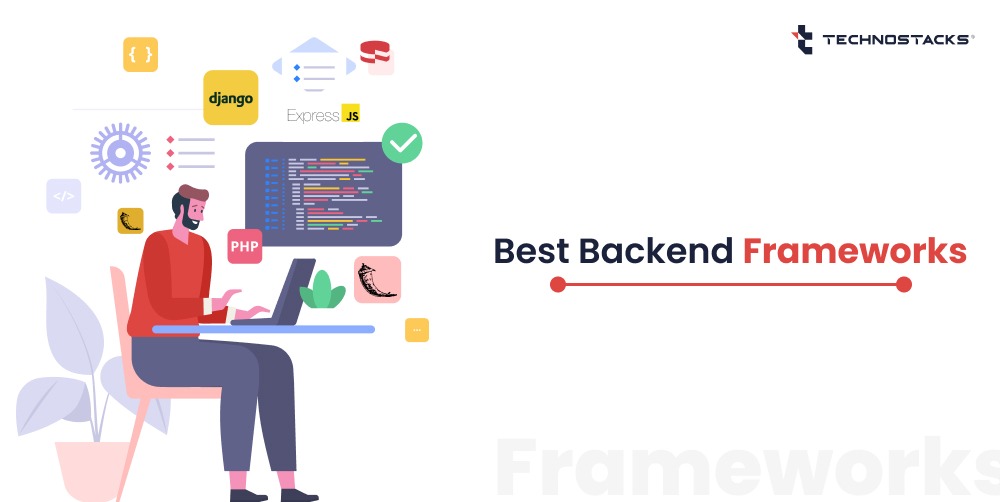Top Backend Frameworks for Web Development
Backend frameworks are the essential building blocks when it comes to application development for brands around the globe. Without a backend framework, your website will not stand.
With the availability of so many frameworks, it is difficult to understand which one works the best. Before we jump into the top backend frameworks, let’s look at what a backend framework is and why you should use it.
What is a Backend Framework?
Backend frameworks are server-section frameworks created to make tasks hassle-free for developers.
These web application frameworks are focused more on scripting languages such as JavaScript, Laravel, and Node.js or compiled languages such as Java and C#. Backend development focuses more on business logic and security authorization and authentication.
Why Should You Use a Backend Framework?
The main objective of a backend framework is to better automate the overheads correlated with software development aspects.
Some advantages of using backend frameworks for web development are:
- Time-saving features
- Scalability
- Security
- Robustness
- Integrations
Besides this, it is important to remember that most are open-source backend frameworks.
Best Backend Frameworks for 2025
1. Django
Django is an open-source backend framework based on Python and follows the MVC structure. It was created to develop feature-rich, database-driven sites and is one of the easiest backend development frameworks to work with.
Features of Django:
- Superior Scalability
- Higher Security
- Swift Development
- SEO Optimized
Advantages of Django:
- Low learning curve for backend developers.
- Comes with built-in features like user authentication, content administration, and sitemaps.
- Prevents security vulnerabilities such as clickjacking, cross-site scripting, request forgery, and SQL injection.
- Versatile and supports content management systems, computing platforms, and social networking applications.
- Highly scalable.
Disadvantages of Django:
- Developers have less control over the workflow.
- Not suitable for minor projects as it requires extensive coding.
- Lacks conventions, leading to slow development speed.
Examples: The Washington Times, Mozilla
Read More: Reasons to Choose Django For Web Development
2. Laravel
Laravel is an open-source backend framework used for Symfony-based applications with a Model-View-Controller (MVC) architecture.
Features of Laravel:
- MVC Architecture Support
- Safe Migration
- Exclusive Unit-testing
- Complete Security
Advantages of Laravel:
- Simple API with drivers for Amazon SES, Mandrill, SparkPost, and SMTP.
- Easy authentication implementation.
- Pre-configured error handling with Monolog library integration.
- Supports multiple cache backends like Memcached and Redis.
Disadvantages of Laravel:
- Comparatively slower than other frameworks.
- Occasional updates can be risky.
- Limited support compared to Django and Ruby on Rails.
Examples: Pfizer, BBC
3. Express.js
Express.js is a Node.js web application framework available under the MIT license. It is widely used for building web applications and enabling APIs.
Features of Express.js:
- Faster Server-Side Development
- Middleware Support
- Routing and Templating
- Faster Debugging
Advantages of Express.js:
- Uses JavaScript for both frontend and backend.
- Easy to learn and use.
- High performance due to the V8 JavaScript engine.
Disadvantages of Express.js:
- Not optimal for large projects.
- Lacks a well-defined body parser.
- No built-in security features.
Examples: MySpace, PayPal, IBM
4. Flask
Flask is a lightweight Python-based backend framework.
Features of Flask:
- Development Server and Debugger
- Unit Testing
- RESTful Request Dispatching
- Jinja Templating
Advantages of Flask:
- Modular components can be modified.
- Simple and easy to configure.
- Suitable for high-performance applications.
Disadvantages of Flask:
- No built-in admin or authentication system.
- Difficult for extensive applications.
- Limited community support.
Examples: Airbnb, Netflix
Read More: Best JavaScript Frameworks For Developers
5. Spring Boot
Spring Boot is an open-source Java-based backend framework.
Features of Spring Boot:
- Spring Application
- App Events and Listeners
- YAML Configuration
- Embedded Server Support
Advantages of Spring Boot:
- No boilerplate configuration needed.
- Embedded servers like Tomcat and Undertow.
- Easy dependency management.
Disadvantages of Spring Boot:
- High learning curve.
- Large deployment file size.
- Not ideal for high-volume applications.
Examples: Udemy, Trivago
6. Ruby on Rails
Ruby on Rails is an MVC-based framework for Ruby.
Features of Ruby on Rails:
- Object-Oriented
- Automated Testing
- Server-side Scripting
Advantages of Ruby on Rails:
- Provides ready-made plugins and modules.
- Open-source with an MIT license.
- Highly scalable.
Disadvantages of Ruby on Rails:
- Slower runtime speed.
- Lacks proper documentation.
- Less flexibility for unique projects.
Examples: Etsy, Urban Dictionary, Dribbble
Read More: Reasons Why Choose Python As Your Next Web Project
7. Koa
Koa was designed by the Express team to offer a more robust foundation for web applications.
Features of Koa:
- Small Footprint
- ES6 Generators
- Enhanced Error Handling
- Context Object Utilization
Advantages of Koa:
- Fully customizable.
- Easier to learn than other frameworks.
- Fast rendering and templating.
Disadvantages of Koa:
- Requires a separate router installation.
- Limited community support.
- Only compatible with Node.js.
Examples: Brainhub, LetzChange, GAPO
8. CakePHP
CakePHP is a PHP-based MVC backend framework.
Features of CakePHP:
- PHP Compatibility
- MVC Architecture
- App Scaffolding
Advantages of CakePHP:
- Reusable code across multiple projects.
- CRUD functionality.
- Data conversion techniques.
Disadvantages of CakePHP:
- No default routing system.
- Difficult documentation.
- Challenging version migration.
Examples: Hyundai, Express, BMW
9. ASP.NET Core
ASP.NET Core is a cross-platform backend web framework.
Features of ASP.NET Core:
- Cross-platform Support
- High Performance
- Asynchronous Processing
- Integrated MVC
Advantages of ASP.NET Core:
- Less code, easier maintenance.
- Cross-platform support (Mac, Linux, Windows).
- Frequent updates improve performance.
Disadvantages of ASP.NET Core:
- No built-in authentication.
- Expensive due to licensing.
- Version changes require significant code updates.
Examples: Dell, GoDaddy, Ancestry.com
10. Play Framework
Play Framework is a Java and Scala-based backend framework.
Features of Play Framework:
- Hot Code Reloading
- Built-in Testing
- IDE Support
Advantages of Play Framework:
- Fast framework for multi-project work.
- Easy testing.
- Intuitive UI.
Disadvantages of Play Framework:
- Not beginner-friendly.
- No backend compatibility.
- Hard-to-understand architecture.
Examples: LinkedIn, Accenture, Deloitte
11. Phoenix
Phoenix is an Elixir-based backend framework.
Features of Phoenix:
- Authentication
- Real-time Features
- In-depth Testing
Advantages of Phoenix:
- High reliability.
- Supports high concurrency.
- Self-healing capabilities.
Disadvantages of Phoenix:
- Limited community and resources.
- Hard to find Elixir developers.
Examples: Fresha, Stack Scanner, Quero
12. Fiber
Fiber is a high-performance Golang backend framework.
Features of Fiber:
- Optimized Speed
- Simple Routing
- Static File Serving
Advantages of Fiber:
- Built-in middleware.
- Extremely fast performance.
- Low memory consumption.
Disadvantages of Fiber:
- No HTTP 1.0 or 2.0 support.
- Small community.
- No significant performance boost.
Examples: Spacehut, Modanisa, Cartesius
Key Takeaways
When choosing a backend framework, you need to check which one matches the project you are working on. Our comprehensive list of the best backend frameworks and their advantages and disadvantages will help you choose. Before jumping in, it is best to research it and see what the community thinks.
We at Technostacks, a leading web development company, have an experienced in working with the global clients. An expert team of dedicated backend developers at Technostacks can able to meet with your project requirements.
Contact us for more information.
FAQs for Best Backend Frameworks
1. What is a backend framework?
Backend frameworks also known as server side programming languages libraries and it is mainly used for building the backend structure of the website. It offers ready to use functions to create a robust websites.
2. Which backend framework is mostly used?
Using a backend framework depends on the type of web app you want to build. Laravel and Django are the most utilized and exclusive backend frameworks. Some other most leveraged backend frameworks include Flask, ExpressJS, Ruby on Rails, Spring, and NestJS.
3. What are the best backend frameworks, and why?
The best backend frameworks are Laravel, Django, Flask, ExpressJS, Ruby on Rails, Spring, and NestJS. These frameworks are easy to use and learn, can be easily scalable, and offers proper documentation.
4. Is Nodejs a backend framework?
A typical misunderstanding that most people have is that Node.JS is merely a backend framework. In reality, Node.js can be used for both frontend and backend programming. Node.js enables server-side code with superior proficiency and it offers a larger bandwidth to manage big-sized projects.
5. What is the easiest backend framework?
The easiest and most approachable backend framework is Django. It is built on Python and has an MVC architectural pattern. It is suitable for developing feature-rich websites that are database-driven.
6. Which backend framework is most popular?
Depending on the project and the requirements, developers choose which programs work better. The easiest backend framework to use is Django, and some of the most popular ones are Laravel, Django, ExpressJS, Flask, Spring, and Ruby on Rails.
As per the developer’s community feedback, Django is the most popular backend framework to use. It provides optimal security and a set of rich features to build a extensive web applications. Other popular frameworks are Laravel, ExpressJS, Flask, Spring, and Ruby on Rails.
7. Is Python used for the backend?
Python can be used for both backend and frontend development. Its easily approachable syntax and widespread server-side enablement make Python ideal for backend development.
8. Is React frontend or backend?
React.Js is a frontend programming language that uses client-side programming to build aspects of the website that users will see and interact with. It is an open-source framework based on JavaScript, maintained by Meta, and popular for its virtual DOM.
9. Which language is best for the backend?
Some languages that are best for backend development are
- Python
- PHP
- Java
- C#
- JavaScript
10. What backend should I learn in 2025?
If you are planning to learn some backend languages, then start with Python. This multi-purpose language is used for web development and data analysis. Also, multiple backend frameworks are written in Python.








